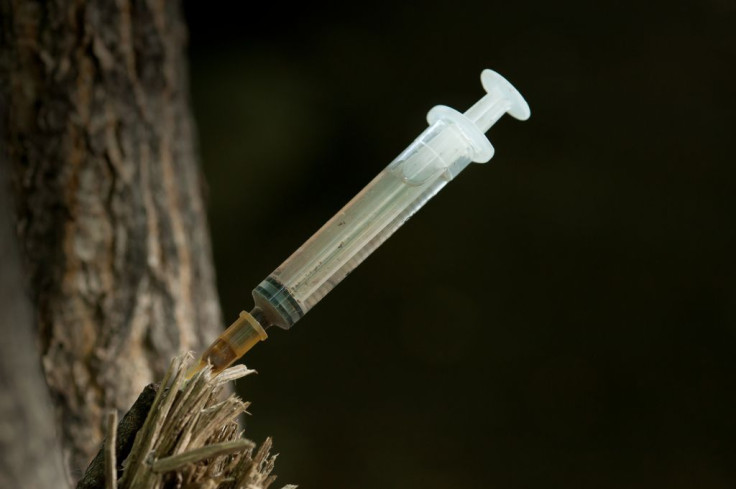America's Heroin Epidemic Explained: The Number Of People Under The Age Of 25 Using Heroin Has Doubled In The Past Decade

It’s easy to turn a blind eye to the current heroin epidemic the United States finds itself in. Most people are under the impression that no one close to them has a problem with addiction, no one close to them will ever have a problem with addiction, or people who have a trouble with addiction are a flaw in the human species. Only if they knew how quickly and easy anyone can pick up a smack habit. A report by the Centers for Disease Control and Prevention shows that heroin use in the U.S. is only becoming more common among people with historically low drug abuse rates.
“Heroin use is increasing at an alarming rate in many parts of society, driven by both the prescription opioid epidemic and cheaper, more available heroin,” Dr. Tom Frieden, CDC director, said in a statement. “To reverse this trend, we need an all-of-society response — to improve opioid prescribing practices to prevent addiction, expand access to effective treatment for those who are addicted, increase use of naloxone to reverse overdoses, and work with law enforcement partners like DEA to reduce the supply of heroin.”
A similar investigation by the New York City Department of Health and Mental Hygiene revealed that the number of fatal heroin overdoses in NYC had doubled over the past four years. The CDC’s investigation alongside the Food and Drug Administration not only found that heroin use among Americans between the ages of 18 and 25 had doubled in the past decade, but also that the number of fatal heroin overdoses had nearly quadrupled in the same timeframe with more than 8,200 deaths in 2013 alone.
Prior addiction to prescription opioid painkillers proved to be the strongest risk factor associated with heroin abuse and dependence. People who abuse prescription painkillers are 40 times more likely to move on to heroin. Marijuana users, on the other hand, are three times more likely to move on to heroin and alcohol users two times more likely. While nearly all heroin addicts used at least one other drug, most used at least three other drugs.
“Approximately 120 people die each day in the United States of a drug overdose,” explained DEA Acting Administrator Chuck Rosenberg. “The CDC’s Vital Signs illustrates two significant factors partly fueling that alarming number — the misuse of prescription drugs and a related increase in heroin use. We will continue to target the criminal gangs that supply heroin, and we will work to educate folks about the dangers and to reduce demand. In this way, we hope to complement the crucial efforts of the CDC and our nation’s public health agencies.”
Non-Hispanic whites, men, people between the ages of 18 and 25, uninsured people, people receiving Medicaid, and people with an annual household income below $20,000 have historically held the highest rates for heroin use. The past 10 years have seen a significant narrowing of the gap between groups most at-risk for heroin abuse and people least at-risk, including women, people with private insurance, and people with higher incomes.
Perhaps the most unsettling finding from the report is that the true number of heroin users in America could be much higher. Although data was gathered from demographic and substance using groups, it was not exhaustive. Researchers did not include homeless people, people in the military, and inmates. These three groups tend to have the highest rates of substance abuse.
So what’s being done about America’s dirty, not-so-little secret? The CDC recommends a three-step approach for responding to the heroin epidemic: Prevent people from starting heroin by identifying high-risk individuals, Reduce heroin addiction by increasing access to Medication-Assisted Treatment (MAT), and Reverse heroin overdoses by expanding the use of naloxone, a potentially life-saving drug that reverses the effects of a heroin overdose.
"We are working with federal, state and local partners to increase access to effective treatment, while reducing overdoses and other consequences of the opioid epidemic, including the spread of Hepatitis C and HIV," said Michael Botticelli, director of National Drug Control Policy. "It is not enough to simply reverse overdoses. We must also connect overdose victims and people struggling with prescription drug and heroin use disorders to treatment facilities and doctors that offer medication-assisted treatment."
Solving the heroin epidemic in America is a dubious proposition. After all, its roots in the U.S. trace back to the mid 1800s. Identifying people who abuse prescription opioid painkillers is a start, but one might wonder why certain opioid medications, such as Vicodin, OxyContin, and Opana, are so easy to obtain in the first place. Health care providers were responsible for 259 million painkiller prescriptions in 2012. To put that into perspective, that’s the equivalent of every American adult having a bottle of pills on hand.
One thing's for certain: People looking to further the heroin epidemic will go above and beyond to keep their “customers” satisfied. Just take a look at these young entrepreneurs:
Published by Medicaldaily.com



























